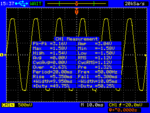gravi
Full Member level 2

- Joined
- May 30, 2006
- Messages
- 128
- Helped
- 10
- Reputation
- 20
- Reaction score
- 10
- Trophy points
- 1,298
- Location
- Hyderabad, India
- Activity points
- 2,452
Hi everyone,
Hi,
We are trying to read AC 230 Volts using an Op-Amp MCP6292 and Output is interfaced with dSPIC30F5011, The Output is 2.5 Volts Sinusoidal wave, When opamp output is tested with multimeter we could find 2.5V dc and 0.94 v AC. 2.5 V dc remains same from 0 - 280 Volts AC, AC output voltage varies proportional to Input Voltage. We were able to read 2.5 V DC using micro controller adc, we are trying to read AC voltage. Is there any other process involved in reading AC voltages. Please find the oscilloscope screen shot also attached.
Thanking You,
Ravi Kumar G
Hi,
We are trying to read AC 230 Volts using an Op-Amp MCP6292 and Output is interfaced with dSPIC30F5011, The Output is 2.5 Volts Sinusoidal wave, When opamp output is tested with multimeter we could find 2.5V dc and 0.94 v AC. 2.5 V dc remains same from 0 - 280 Volts AC, AC output voltage varies proportional to Input Voltage. We were able to read 2.5 V DC using micro controller adc, we are trying to read AC voltage. Is there any other process involved in reading AC voltages. Please find the oscilloscope screen shot also attached.
Thanking You,
Ravi Kumar G


